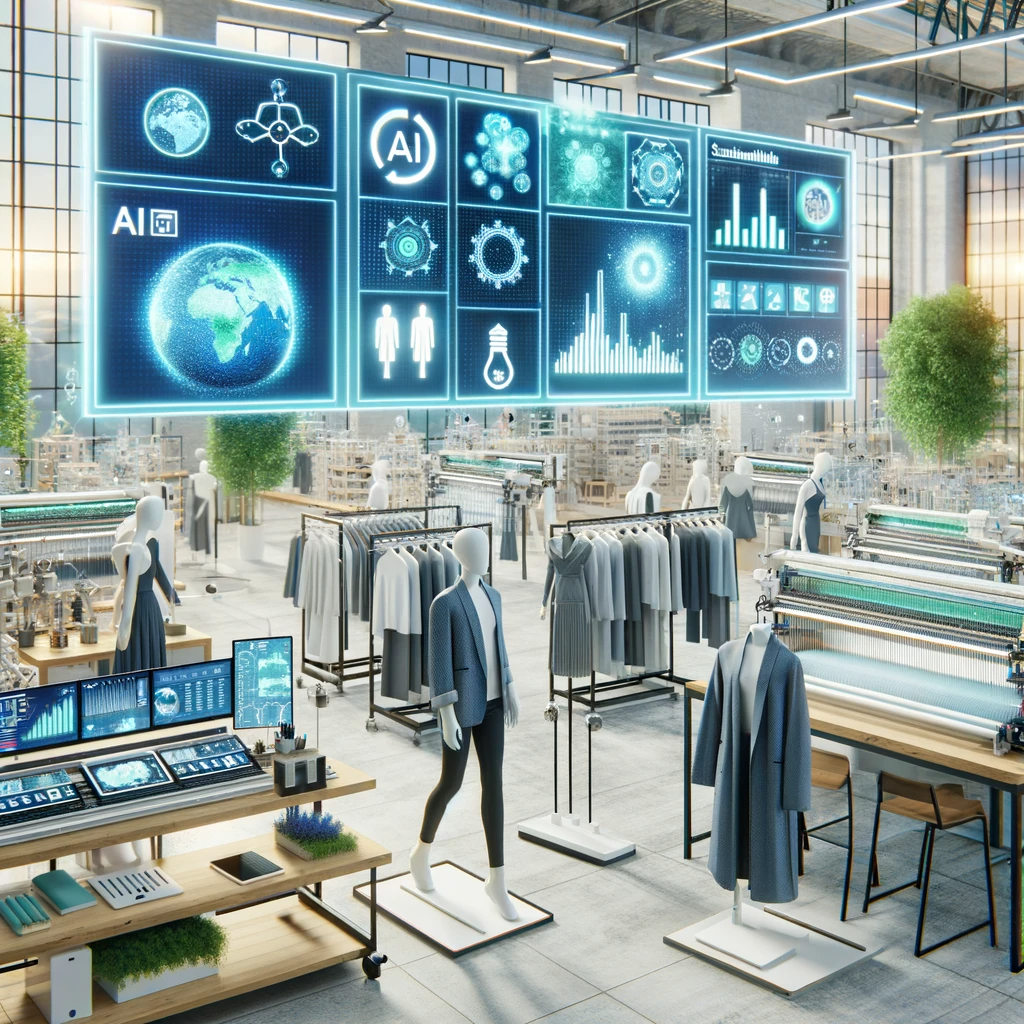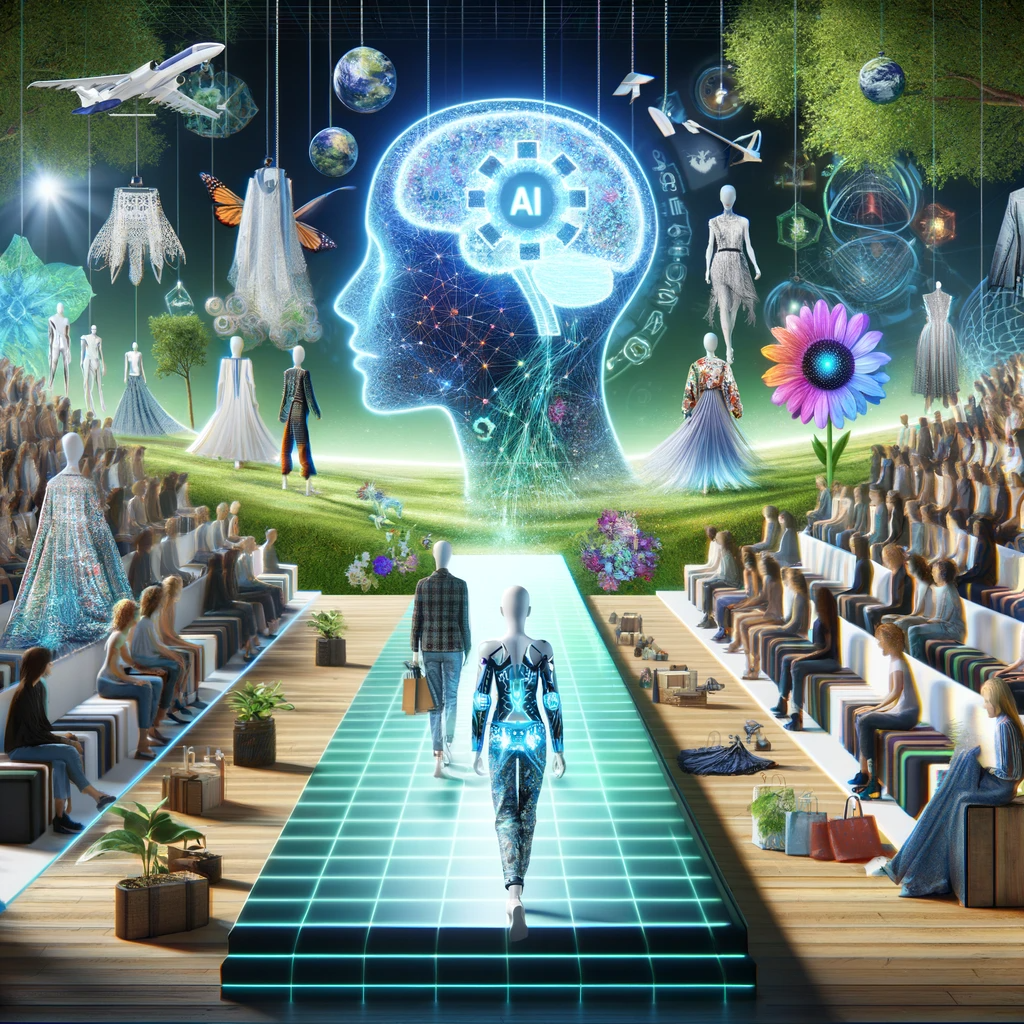In an era where the fashion and textile industry stands at a crossroads between opulence and environmental responsibility, the imperative for sustainability has never been more pressing. The allure of fast fashion, characterized by its swift production cycles and rapidly changing trends, has too often come at a cost – a cost paid by the planet in terms of excessive waste and pollution, and by vulnerable labor forces enduring substandard working conditions. The clamor for change has sparked a transformative synergy between technology and fashion, where Artificial Intelligence (AI) emerges as a beacon of hope in the pursuit of eco-conscious and ethical practices.
The potential of AI in reshaping the fashion and textile industry is boundless, offering innovative solutions from material selection to supply chain management that can steer the industry toward a more sustainable future. In this article, we embark on a journey through the realms of fashion and textiles, exploring how AI can catalyze change, reduce environmental impact, and champion ethical values. From reimagining material choices to optimizing production processes, AI’s capacity to drive sustainability is poised to revolutionize an industry long criticized for its unsustainable practices. Join us as we delve into the transformative role of AI in crafting sustainable fashion and textile practices, offering a glimmer of hope for a more responsible and conscientious fashion landscape.
The Sustainability Imperative in Fashion and Textiles
In recent years, the fashion and textile industry has faced mounting scrutiny over its environmental and ethical practices. The relentless pursuit of fast fashion, marked by rapid production cycles and a throwaway culture, has resulted in staggering waste and pollution levels. Landfills overflow with discarded garments, and the industry’s carbon footprint rivals that of the aviation and shipping sectors combined. Furthermore, the ethical concerns surrounding labor practices within the industry have cast a shadow on its reputation, with stories of exploitation, low wages, and unsafe working conditions making headlines.
The Sustainability Imperative is not merely a buzzword but a clarion call for the fashion and textile industry. It resonates with the growing awareness that our planet cannot bear the burden of unsustainable practices any longer. The environmental impact of fashion’s linear production model, from resource-intensive material extraction to energy-intensive manufacturing and transportation, has been profound. The fashion industry is responsible for 10% of global carbon emissions, and it consumes vast amounts of water and chemicals.
Simultaneously, ethical concerns surrounding labor practices have continued to dog the industry. From sweatshops to child labor, the fashion supply chain has been riddled with issues that demand rectification.
Yet, the tide is turning, and technology, particularly Artificial Intelligence (AI), is at the forefront of this transformation.
AI and Material Selection
AI’s potential in reshaping the fashion industry begins with sustainable material selection. AI algorithms can analyze the environmental footprint of various materials, taking into account factors such as resource usage, energy consumption, and waste generation. This allows designers and manufacturers to make informed choices when selecting materials for their products.
The journey towards sustainability often commences with the selection of materials. Traditional methods of material sourcing and selection often prioritize cost and aesthetic appeal over environmental considerations. However, AI has emerged as a game-changer in this aspect.
Artificial Intelligence, armed with massive datasets and advanced algorithms, can evaluate materials based on their environmental impact. It can take into account factors such as water usage, energy consumption, carbon emissions, and toxicity levels associated with each material. This analysis empowers designers and manufacturers to make choices that are not only aesthetically pleasing but also eco-friendly.
Furthermore, AI-driven tools can suggest alternative materials that can replace traditional, more harmful options. This not only reduces the environmental footprint but can also lead to cost-efficiency gains for fashion brands. The integration of AI into material selection aligns profitability with responsibility, a significant step towards a more sustainable fashion industry.

AI in Sustainable Design and Production
The fashion and textile industry’s transformation toward sustainability extends to design and production processes. AI-driven generative design is revolutionizing product development by optimizing designs to minimize material waste and maximize functionality. These generative algorithms create designs that are not only aesthetically pleasing but also eco-conscious.
Once materials have been responsibly chosen, the sustainability journey continues into the realms of design and production. Here, AI’s transformative potential shines brightly.
Generative design, powered by AI, is changing the game in sustainable fashion. This innovative approach optimizes product designs to reduce material waste while enhancing functionality and aesthetic appeal. Traditionally, design processes would often prioritize aesthetics without considering the environmental impact. However, AI-driven generative design creates product designs that are both visually pleasing and eco-conscious.
Furthermore, AI plays a significant role in optimizing production processes. Predictive maintenance, a capability offered by AI, ensures that machinery operates efficiently, reducing energy consumption and emissions. Real-time monitoring and optimization of production processes lead to resource savings and a lower environmental footprint.
Case studies of fashion brands that have successfully integrated AI into their production cycles serve as concrete examples of these sustainable advancements. By embracing AI in design and production, these brands have not only improved their environmental impact but have also found cost-effective and innovative ways to create eco-conscious products.
AI and Supply Chain Management
Transparent and efficient supply chains are pivotal for sustainable fashion practices. AI enhances supply chain transparency by enabling the tracking and tracing of raw materials from their source to the finished product. This transparency not only ensures ethical sourcing but also reduces the risk of environmental and social violations within the supply chain.
Sustainable fashion isn’t limited to the design studio or production floor; it extends deep into the supply chain. This section focuses on how AI can revolutionize supply chain management for a more sustainable industry.
One of the critical challenges in achieving sustainability is supply chain transparency. AI plays a pivotal role here by enabling the tracking and tracing of raw materials throughout the entire supply chain. By leveraging technology, fashion brands can verify the authenticity of eco-friendly materials and ensure ethical sourcing practices.
Moreover, AI’s predictive capabilities can be harnessed for demand forecasting and inventory management. By accurately predicting consumer demand and optimizing inventory levels, fashion brands can minimize overproduction and reduce the waste associated with excess stock. This not only contributes to sustainability but also improves cost-efficiency.
Real-world examples of companies that have successfully integrated AI into their supply chain management processes showcase how this technology can lead to reduced supply chain emissions and improved sustainability metrics. Supply chains become more transparent, efficient, and environmentally responsible.
Ethical Labor Practices with AI
The ethical dimension of sustainability in the fashion and textile industry is of paramount importance. This section explores how AI can contribute to fair and ethical labor practices.
The industry has been marred by reports of exploitation, unsafe working conditions, and low wages in various parts of the world. AI technology can serve as a powerful tool for monitoring and ensuring fair labor practices. It can track working conditions, wages, and worker rights, providing real-time insights to fashion brands.
Case studies of companies that have implemented AI to improve working conditions and eliminate exploitation in their supply chain underscore the transformative potential of this technology. By leveraging AI for workforce management and ethical compliance, fashion brands can uphold the rights and dignity of workers while enhancing their sustainability credentials.
Section 6: Overcoming Challenges and Limitations
The transformative potential of AI in fashion and textiles is undeniable, but it is essential to acknowledge and address the challenges and limitations that come with it.
One of the primary concerns is data privacy. As AI relies heavily on data, fashion brands must ensure that customer and employee data is protected. Ethical concerns also include the potential for algorithmic bias, which can reinforce existing inequalities and stereotypes.
The Future of Sustainable Fashion with AI
As we reach the conclusion of our exploration, we look ahead to the future of sustainable fashion with AI as its driving force.
The fashion and textile industry is on the brink of a significant transformation. AI’s potential is poised to unlock new levels of sustainability, efficiency, and innovation. Predictions regarding upcoming innovations and developments are presented, demonstrating how AI will continue to shape the industry.
Moreover, the role of consumers is emphasized as a driving force for sustainable fashion. Individuals are encouraged to make informed choices, supporting brands that prioritize sustainability and ethical practices. The power of collective consumer demand cannot be underestimated in catalyzing positive change in the fashion industry.

Conclusion
In this holistic exploration, we’ve uncovered the profound potential of AI to usher in a new era of sustainability in fashion and textiles. It’s a journey where technology meets conscience, where innovation meets responsibility, and where fashion transforms into a force for positive change in the world. The future of fashion is sustainable, and AI is its guiding light.
The Sustainability Imperative is not just a fleeting trend but an urgent necessity. The fashion and textile industry has long been a symbol of glamour and extravagance, but it’s time for a profound transformation. The pursuit of fast fashion and unsustainable practices has taken a toll on our planet, from excessive waste to pollution, and has cast a dark shadow on labor practices. The statistics and trends are clear: sustainability is no longer a choice but a must.
AI emerges as a beacon of hope in this transformative journey. From the responsible selection of eco-friendly materials to optimizing design and production processes, AI is driving sustainability at every level. It empowers fashion brands to make informed choices, reduce waste, and minimize their ecological footprint.
The supply chain, a critical component of the fashion industry, is revolutionized by AI’s transparency and efficiency. Ethical labor practices are no longer a distant dream but a tangible reality, as AI ensures fair treatment and dignity for workers. However, we must also confront the challenges of data privacy, algorithmic bias, and ethical AI development to ensure that AI’s transformative power aligns with sustainable and ethical goals.
As we look to the future, we see a fashion and textile industry that embraces AI wholeheartedly. Predictions of upcoming innovations and developments fueled by AI’s transformative capabilities give us hope for a more sustainable and responsible industry. Consumers, too, have a significant role to play, as their choices can drive demand for sustainable fashion.
In this journey towards sustainable fashion and textiles, industry stakeholders are urged to seize the opportunity and embrace AI. It’s a call to action for designers, manufacturers, retailers, and consumers alike to collaborate, innovate, and advocate for a fashion industry that not only dazzles with creativity but also stands as a beacon of sustainability and ethical responsibility.
The future of fashion is not just in style but also in substance. It’s a future where fashion and textiles are crafted with care for our planet, respect for our fellow humans, and the transformative power of Artificial Intelligence. It’s a future where fashion truly becomes a force for good, one garment at a time.
